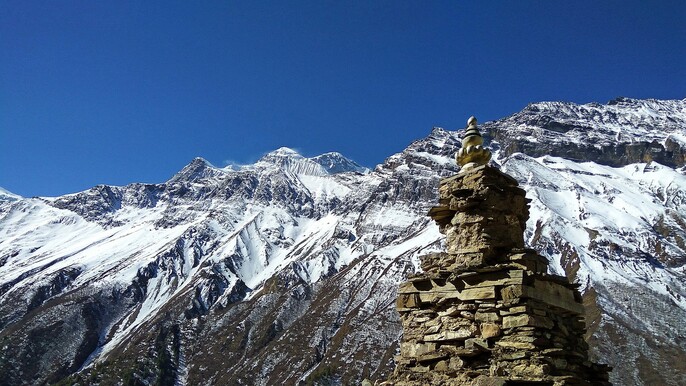Trekking through the once forbidden kingdom of Lo Manthang: Upper Mustang

Description
17 Days Upper Mustang Trekking
The 17 Days Upper Mustang Trekking takes you through the hidden landscapes of Nepal, located on the northwest border within the Annapurna Conservation Area, specifically in the Mustang district.
Exploring the mystical semi-arid landscape, this restricted trek allows you to immerse yourself in the Tibetan Buddhist cultural influence, hidden caves, monasteries, and chortens, offering a unique experience unlike any other part of Nepal.
The magnetic Himalayan aura and seasonal vegetation add to the allure of this trek.
The journey begins from Jomsom airport, the district center of Mustang, situated in a windy valley beyond the Annapurna Himalayan peaks. The trail follows the historic salt trade route along the dramatic Kali Gandaki River gorge to Lo-Manthang.
Since 1992, trekkers have been allowed to explore this hidden jewel of Upper Mustang with a special restricted trekking permit. The whitewashed houses with fluttering prayer flags, built with mud bricks, reflect the cultural richness of the region. The nomadic lifestyle, impressive hospitality, and typical Tibetan cuisine further enhance the experience.
Trekkers pass through picturesque towns like Chele, Syangbochen, Ghyami, and Tsarang, crossing high passes such as Chogo La Pass (4250 meters), the highest on this trek. Lo-Manthang, at an altitude of 3700 meters, is the ultimate destination, once hidden by local kings.
The Chooser Cave and ancient monasteries make Lo-Manthang and its surroundings truly impressive. The trek concludes at the Muktinath Temple, a globally recognized spiritual center. Muktinath is highly recommended for its spiritual significance.
The best time for the Upper Mustang Trek is from March to July and September to December. However, trekking is possible even during the monsoon season, as the Mustang region lies in the Himalayan rain shadow area. Winter can be extremely cold, and the windy valley poses significant challenges. Proper acclimatization is essential to avoid altitude sickness during the journey.
Major Attractions of the Upper Mustang Trek
Upper Mustang: A Must-Visit Destination
The Upper Mustang region is renowned for its unique blend of cultural diversity and natural beauty, attracting tourists from around the world. Here are some of the major attractions:
T-Sarang and Lo-Manthang
- T-Sarang (Charang): A village dominated by the Gallup sect, featuring a 400-year-old monastery.
- Lo-Manthang: The capital of Upper Mustang, located at 3700 meters above sea level, known for its Tibetan Buddhist culture, ancient caves, and colorful monasteries. Note that entrance fees apply.
Tibetan Buddhist Culture
- Once part of Tibet, Upper Mustang retains a deep connection to Tibetan Buddhist culture, attracting trekkers interested in its unique heritage. As a restricted region, it preserves its cultural identity.
Shaligram Fossils in the Kali Gandaki River
- Shaligram, a fossilized shell symbolizing the god Vishnu, is collected from the Kali Gandaki River. Hindu devotees often seek these stones during their trek to Upper Mustang and Muktinath Temple.
Tiji Festival
- Celebrated in May, the Tiji Festival, meaning ‘Prayer for World Peace,’ symbolizes the victory of good over evil. Held in Lo-Manthang, it is a significant event in Tibetan Buddhist culture, drawing travelers from around the globe.
Historical Caves
- Upper Mustang is home to many historical caves, such as Chosar Cave, Chussang Cave, Nuri Gompa Cave, and Yara Caves, each holding cultural and historical significance.
Typical Local People
- The locals, known as Mustangis or Lo Pa, speak Tibetan and follow Buddhism. Their warm hospitality and willingness to share their culture enhance the trekking experience.
Scenic Backdrop
- The region is framed by the majestic peaks of Mt. Annapurna, Fishtail, and Dhaulagiri. Pokhara, with its lakes, caves, waterfalls, and cultural sites, offers a memorable holiday experience with activities like boating, paragliding, and exploring natural wonders.
Upper Mustang is best visited from March to July and September to December. The region’s rain shadow allows for trekking even during the monsoon season, though winter can be extremely cold and challenging. Proper acclimatization is essential to avoid altitude sickness.
Included
- Pick up and drop off from the international and domestic airport by private tourist a/c vehicle.
- Hotel in Pokhara, in bed and breakfast plan for two nights.
- Hotel in Kathmandu, in bed and breakfast plan for three nights.
- Standard accommodation during the trekking.
- Three meals during the trekking (Breakfast, Lunch, and Dinner) with neat and clean lodges on the mountain
- Private a/c transportation for sightseeing activities with a tour guide.
- Required paperwork for the trekking (TIMS card and entry permits)
- Restricted permits of Upper Mustang.
- Kathmandu-Pokhara-Kathmandu round trip by a/c bus (or flight ticket in extra coverage)
- Pokhara-Jomsom-Pokhara plane tickets.
- A professional trekking guide who can communicate well in English
- Salary for the guide, his insurance, food, accommodation, and transportation
- A cup of Nepali tea with every meal.
- Government tax
- Domestic airport tax according to the itinerary.
Excluded
- Entrance fee during your sightseeing in Kathmandu and Pokhara.
- A porter and his flight tickets.
- Hard and soft drinks.
- Extra accommodation and activities in Pokhara.
- Horse riding.
- Miscellaneous expenses like battery recharge, shower, water bottle, and so on
Know before you go
When preparing for your 17 Days Upper Mustang Trek, it’s essential to pack wisely to ensure a comfortable and enjoyable journey. Here’s a comprehensive packing list for male and female trekkers:
Clothing and Footwear:
- Warm Jacket with Hood: A waterproof and breathable jacket to protect against cold and wind.
- Hiking Pants: Breathable, windproof, and waterproof pants for trekking.
- Hiking Shorts: Lightweight and weather-resistant shorts.
- Thermal Trousers: For extra warmth during chilly evenings.
- Full-Sleeve Shirts: Both woolen and cotton shirts.
- Bandana or Head Scarf: Useful for sun protection and dust.
- Regular Underwear: Comfortable underwear for daily wear.
- Woolen Hat & Sun Hat: Keep your head warm and shielded from the sun.
- Gloves: Insulated gloves for cold weather.
- Trekking Boots (Waterproof): Sturdy boots with good ankle support.
- Socks: Woolen and cotton socks for comfort.
- Sandals: Lightweight sandals for relaxing at tea houses.
- Sunglasses with UV Protection: Essential for high-altitude glare.
- Small Daypack & Medium Rucksack: To carry essentials during the day and larger items for the trek.
- Large Duffel Bag: For storing extra gear (provided by the company).
- Padlocks for Duffel-Kit Bags: Keep your belongings secure.
- Trekking Poles: Helpful for stability on uneven terrain.
- Sleeping Bag: A warm, 4-season sleeping bag (to be returned after the trek).
- Headlamp: Useful for evening activities and reading.
Other Essential Items:
- Personal Medical Kit: Including basic first aid supplies.
- Water Purification Tablets: Ensure safe drinking water.
- Earplugs: For a good night’s sleep.
- Sewing-Repair Kit: Handy for minor repairs.
- Camera: Capture the stunning landscapes.
- Knife: Multi-purpose tool.
- Water Bottles: Stay hydrated.
- Quick-Drying Towel: Lightweight and compact.
- Toothbrush/Paste: Maintain oral hygiene.
- Multi-Purpose Soap: For personal hygiene.
- Nail Clippers: Keep nails tidy.
- Moisturizer and Sunscreen: Protect your skin.
- Reading Book: Entertainment during downtime.
- Notebook and Pen: Jot down memories or observations.
- Trek Route Map: Stay oriented.
- Tissue/Toilet Roll: Essential for restroom breaks.
- Anti-Bacterial Hand Wash: Maintain hygiene.









